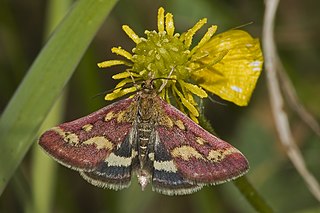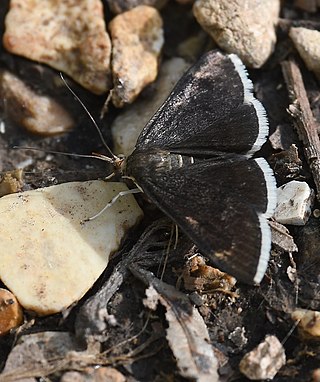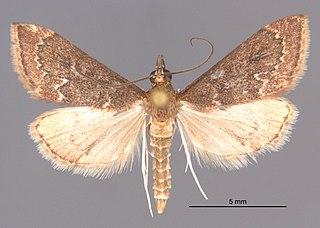
Crambidae comprises the grass moth family of lepidopterans. They are variable in appearance, with the nominal subfamily Crambinae taking up closely folded postures on grass stems where they are inconspicuous, while other subfamilies include brightly coloured and patterned insects that rest in wing-spread attitudes.

The mint moth is a small moth from the family Crambidae, also known by the common name Small Purple and Gold.

Pyrausta cingulata, the silver-barred sable, is a species of moth of the family Crambidae. It was described by Carl Linnaeus in his 1758 10th edition of Systema Naturae. It is found in Europe.

Pyrausta purpuralis is a species of moth of the family Crambidae. It was described by Carl Linnaeus in his 1758 10th edition of Systema Naturae

Pyrausta ostrinalis, also called the scarce purple and gold, is a species of moth of the family Crambidae. It was described by Jacob Hübner in 1796 and is found in Europe and North Africa.

Pyrausta nigrata is a species of moth of the family Crambidae. It was described by Giovanni Antonio Scopoli in his 1763 Entomologia Carniolica and it is found in Europe.

Pyrausta is a speciose genus of moths of the family Crambidae. The genus was erected by Franz von Paula Schrank in 1802.

Pyrausta porphyralis is a species of moth in the family Crambidae described by Michael Denis and Ignaz Schiffermüller in 1775. It is found in most of Europe.

Pyrausta virginalis is a species of moth in the family Crambidae. It is found in southern Europe, Turkey, Armenia and Afghanistan.

Pyrausta phoenicealis, the perilla leaf moth, is a moth of the family Crambidae described by Jacob Hübner in 1818. It is found worldwide, including the Americas, Africa, Australia and Asia.

Pyrausta aurea is a moth in the family Crambidae. It was described by George Hampson in 1913. It is found from Nevada, southern Arizona, southern Texas and Mexico south at least to Costa Rica.
Pyrausta alexandra is a moth in the family Crambidae. It was described by Ayuna A. Shodotova in 2010. It is found in Transcaucasia.
Pyrausta klotsi is a moth in the family Crambidae. It was described by Eugene G. Munroe in 1976. It is found in North America, where it has been recorded from southern Arizona, New Mexico and Texas.

Pyrausta lethalis, the lethal pyrausta moth, is a moth in the family Crambidae. It was described by Augustus Radcliffe Grote in 1881. It is found in North America, where it has been recorded from California to southern Nevada, southern Arizona and Texas.

Pyrausta niveicilialis, the white-fringed pyrausta moth, is a moth in the family Crambidae. It was described by Augustus Radcliffe Grote in 1875. It is found in North America, where it has been recorded from southern Canada to Florida and west to Colorado.

Pyrausta roseivestalis is a moth in the family Crambidae. It was described by Eugene G. Munroe in 1976. It is found in North America, where it has been recorded from California and southern Arizona.

Pyrausta rubricalis, the variable reddish pyrausta moth, is a moth in the family Crambidae. It was described by Jacob Hübner in 1796. It is found in North America, where it has been recorded from Illinois to New York, south to Florida and Louisiana. It is also reported from the west coast, from southern California to Washington. The wingspan is about 15 mm and adults have been recorded on wing from March to October.

Pyrausta subsequalis, also known as the weedfield sable, is a moth in the family Crambidae. It was described by Achille Guenée in 1854. It is found in much of North America, where it has been recorded from southern Alberta and southern British Columbia south to Arizona and New Mexico and east to Florida and north to Ontario. The habitat consists of dry prairie areas.

Pyrausta tithonialis is a moth in the family Crambidae. It was described by Zeller in 1872. It is found in Russia, China, Korea and Japan.

Pyrausta unifascialis, the one-banded pyrausta, is a moth in the family Crambidae. It was described by Alpheus Spring Packard in 1873. It is found in North America, where it has been recorded from Quebec west to British Columbia, south to Arizona and California. The habitat consists of forest openings, clearings and fields.
















